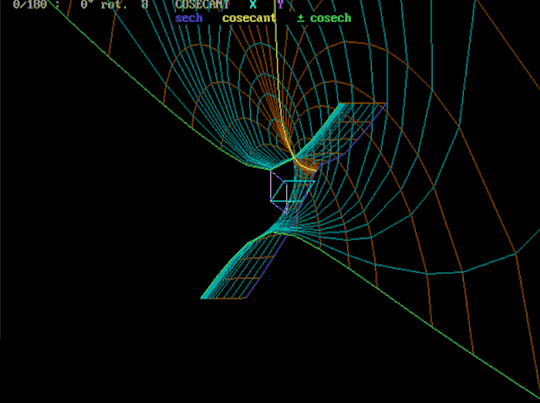Photo

Bertrand’s Paradox: https://en.wikipedia.org/wiki/Bertrand_paradox_(probability)
Random chords defined by a point in the disk, and a slope.
Try to determine the probability of a “longer than SQR(3)” chord.
The points within the inner circle, half-radius, define 100% longer chords!
The points between half- and unit-radius circles define longer chords in the angle between both tangent lines. All chords outside this angle are shorter chords.
The points are shown evolving along a radius. The slopes defining longer chords are occupying the white area. The slopes defining the shorter chords are occupying the grey area.
The total probability of points+slopes defining longer chords is the integral of the ratio between the white area and the full circle area, PI*r^2. Integral to be taken along a radius.
The total probability of defining shorter chords is the integral of the ratio between the gray areas and the full circle area.
Anyone interested in calculating those, for comparison with our ~60.1% result looking at the equilateral triangle and the three lunes?
0 notes
Photo

Bertrand’s Paradox: https://en.wikipedia.org/wiki/Bertrand_paradox_(probability)
Random chords defined by a point in the disk, and a direction.
In all cases the points in the disk have a ~60.1% probability of defining a “longer” chord, and a ~39.9% probability of defining a shorter chord.
The longer chords occupy the equilateral inner triangle and roughly one (third) of the lunes. The shorter chords occupy two (thirds of the) lunes. The lunes scan the area between disks of full and half radius. So this can be redefined as: the longer chords (red) occupy the smaller disk and roughly 47% of the area between half and full radius circle. The shorter chords (cyan) occupy 53% of the latter area.
NB: ‘occupy’ to be read as probability of a chord in a point in named area being longer or shorter.
Source: https://www.desmos.com/calculator/yvuvxhoo45?lang=nl by fellow usenetter “sobriquet” of nl.wetenschap.
1 note
·
View note
Photo

Bertrand’s Paradox:
https://en.wikipedia.org/wiki/Bertrand_paradox_(probability)
Random chords defined by a point on the circle, and a second point in the disk.
Another distribution: a point in the disk, and a slope.
Overall the points in the disk have a ~60.1% probability of defining a “longer” chord, and a ~39.9% probability of defining a shorter chord.
The longer chords occupy the triangle and one (third) of the lunes. The shorter chords occupy (two thirds of) the lunes. The lunes cover the area between circles of full and half radius.
This can be redefined as: the longer chords occupy the half-radius disk (green) and roughly 47% of the space between half- and full-ray circles. The shorter chords occupy roughly 53% of the latter space.
(NB ‘occupy’ to be read as probability of a chord through a point in named area being longer or shorter ;-)
0 notes
Photo

Twin Paradox, “Cockpit View” simulation.
How each twin would really SEE the other one (with Doppler delays and effects)
v = 0.8c
See http://www.wugi.be/qbRelaty.html and http://www.wugi.be/paratwin.htm
0 notes
Photo

Twin Paradox, “Cockpit View” simulation.
How each twin would really SEE the other one (with Doppler delays and effects)
v = 0.5c
See http://www.wugi.be/qbRelaty.html and http://www.wugi.be/paratwin.htm
0 notes
Photo

Twin Paradox, “Cockpit View” simulation.
Lorentz position of the “other” twin according to each twin’s reference system (Traveltwin’s system non-inertial).
See http://www.wugi.be/qbRelaty.html and http://www.wugi.be/paratwin.htm
0 notes
Photo

Complex Function graphs Y=F(X): the Cosecant Y = csc X
4D surface with plane of imaginary axes rotating around real plane (and curve).
See http://www.wugi.be/qbComplex.html and
https://www.youtube.com/watch?v=0iZeM_lGTz8
0 notes
Photo

Complex Function graphs Y=F(X): the Tangent Y = tan X
4D surface with plane of imaginary axes rotating around real plane (and curve).
See http://www.wugi.be/qbComplex.html and
https://www.youtube.com/watch?v=0iZeM_lGTz8
0 notes
Photo

Complex Function graphs Y=F(X): the Cosine Y = cos X
4D surface with plane of imaginary axes rotating around real plane (and curve).
See http://www.wugi.be/qbComplex.html and
https://www.youtube.com/watch?v=0iZeM_lGTz8
0 notes
Photo

Complex Function graphs Y=F(X): the Exponential Y = e^X
4D surface with plane of imaginary axes rotating around real plane (and curve).
See http://www.wugi.be/qbComplex.html and
https://www.youtube.com/watch?v=0iZeM_lGTz8
0 notes
Photo

Complex Function graphs Y=F(X): the Parabola Y = X^2
4D surface with plane of imaginary axes rotating around real plane (and curve).
See http://www.wugi.be/qbComplex.html and
https://www.youtube.com/watch?v=0iZeM_lGTz8
0 notes
Photo

Complex Function graphs Y=F(X): the Square Hyperbola Y = 1/X^2
4D surface with plane of imaginary axes rotating around real plane (and curve).
See http://www.wugi.be/qbComplex.html and
https://www.youtube.com/watch?v=0iZeM_lGTz8
0 notes
Photo

Complex Function graphs Y=F(X): the Circle-Hyperbola Y = 1/X
4D surface with plane of imaginary axes rotating around real plane (and curve).
See http://www.wugi.be/qbComplex.html and
https://www.youtube.com/watch?v=0iZeM_lGTz8
0 notes
Photo

Twin Paradox, How the Twins would See each other! POV of Traveltwin, in both twins’ reference systems (home left, travel right, the latter not inertial). See https://www.youtube.com/watch?v=WouPS_umfks
0 notes
Photo

Twin Paradox, How the Twins would See each other! POV of Hometwin, in both twins’ reference systems (home left, travel right, the latter not inertial). See https://www.youtube.com/watch?v=WouPS_umfks
0 notes
Photo

Twin Paradox, Growing Twins simulation. POV of Traveltwin, in both twins’ reference systems (home right, travel left, the latter not inertial). See https://www.youtube.com/watch?v=bNJYOFD1q3Q
0 notes
